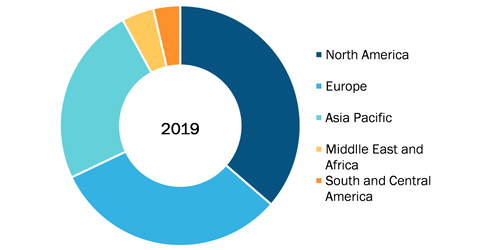Full-field Digital Mammography System Segment to Hold Major Mammography Systems Market Share During 2020–2027
According to our latest study on “Mammography Systems Market Forecast to 2028 – COVID-19 Impact and Global Analysis – by Product, Technology, End User, and Geography,” the market is valued at US$ 2,712.8 million in 2019 and is expected to reach US$ 3,790.5 million in 2027; it is estimated to record a CAGR of 7.4% from 2020-2027. The report highlights the trends and drivers prevailing in the mammography systems market.
A mammography system is a specific type of X-ray equipment used exclusively for breast imaging with low doses of X-rays that produce images known as mammograms. Mammograms remain an early choice for physicians to detect early breast cancer symptoms and can detect changes in breast tissues. Therefore, countries offer screenings every 2 or 3 years for women from a certain age group. Technological advancements, like a polymerase chain reaction (PCR), and others, the rising application of mammography systems is expected to drive the market during the forecast period.
Mammography Systems Market, by Region, 2019 (%)
Mammography Systems Market Size and Forecast (2021 - 2031), Global and Regional Share, Trend, and Growth Opportunity Analysis Report Coverage: By Product (Analog Systems, Full Field Digital Mammography Systems, Breast Tomosynthesis Systems); Technology (Screen Film, 2D Mammography, 3D Mammography); End User (Hospitals, Ambulatory Surgical Centers, Others), and Geography
Mammography Systems Market Regional Overview by 2031
Download Free Sample
Innovative Product Launches and Developments by Market Players to Drive the Mammography Systems Market Growth and Size During the Forecast Period
Breast cancer screening through mammography system in the US is a life-changing technology now available globally. For example, Hologic, Inc.'s, through the introduction of "Selenia Dimensions," launched the first commercially available system that delivers breast tomosynthesis. The Selnia Dimension system's "Genius 3D Mammography exams" offers the only breast tomosynthesis technology with advantages over 2D mammography. Also, the system is capable of detecting 20%-65% more invasive breast cancers compared to 2D alone, with an average of 41%. Further, Hologic has advanced breast cancer screening by producing 2D images from breast tomosynthesis data using C View software, resulting in a Low Dose Genius 3D Mammography examination with superior clinical performance compared to 2D mammography alone. Such product innovations by the companies further enhance the adoption of mammography systems, thereby dominating the overall market size during the forecast period.
Technology Insights
Based on technology, the global mammography systems market is segregated as 2D mammographs, 3D mammographs, and screen film. The 2D mammograph segment accounted largest market share in 2019. Moreover, the 3D mammograph segment is expected to grow at the highest CAGR during the forecast period. Both 2D and 3D mammography is a specially qualified radiologic technology that is well positioned for mammography units. A conventional 2D mammogram creates two side images of the breast, thereby being capable of detecting small cancers. A 3D mammogram creates multiple thin slices by striving for the tissue overlap, making it easier to view dense breast tissue. Therefore, a 3D mammogram is considered better than a 2D, especially for some women, particularly with dense breasts; a 2D digital mammogram remains the standard of care by offering equivalent diagnostic information among women. Therefore, the 2D mammogram segment accounts for the largest share, thereby dominating the mammography system market size and growth during the forecast period.
Impact of COVID-19 Pandemic on Mammography Systems Market
COVID-19 had a negative impact on the breast cancer screening program globally. According to the American College of Radiology, the report reveals that there was a major drop in screening mammograms by 63.7%, diagnostic mammograms by 42.1%, breast biopsies by 52.7%, and cancer diagnoses by 51.3% compared to pre-pandemic. Such aforementioned findings had a major impact on future biopsies of breast cancer screening. Additionally, amid the pandemic, the cancer diagnoses deficit started in the acute phase of the pandemic resulting in lower screening mammography utilization rates. Failure to diagnose smaller, screen-detected cancers resulted in more late-stage cancer detection. For example, initial cancer registry data demonstrate that late-stage breast cancer resulted in patient morbidity and mortality. Thus, late diagnoses of breast cancer screening has resulted in mortality thereby resulting in sluggish growth of mammography system market growth.
Siemens Healthineers, Carestream Health, General Electric, Hologic, Inc., Koninklijke Philips N.V., PLANMED OY, Fujifilm Corporation, Canon Medical Systems, Metaltronica S.p.A., IMS Giotto S.p.A. among others are among the several players engaged in addressing the growing demands for mammography systems market.
The report segments the Mammography Systems Market as follows:
Based on product, the mammography systems market is segmented as full-field digital mammography systems, breast tomosynthesis systems, and analog systems. The full-field digital mammography systems segment held the largest market share in 2019. Based on technology, the global mammography systems market is segregated as 2D mammographs, 3D mammographs, and screen film. The 2D mammograph segment accounted largest market share in 2019. In terms of end user, the mammography systems market is categorized into hospitals, ambulatory surgical centers, and others. The hospital segment accounts the largest mammography systems market share in 2019. Based on geography, the mammography systems market is segmented into North America (the US, Canada, and Mexico), Europe (France, Germany, the UK, Italy, Spain, and the Rest of Europe), Asia Pacific (China, Japan, India, Australia, South Korea, and the Rest of Asia Pacific), the Middle East & Africa (Saudi Arabia, South Africa, the UAE, and the Rest of Middle East & Africa), and South & Central America (Brazil, Argentina, and the Rest of South & Central America).
Contact Us Phone: +1-646-491-9876Email Id: sales@theinsightpartners.com